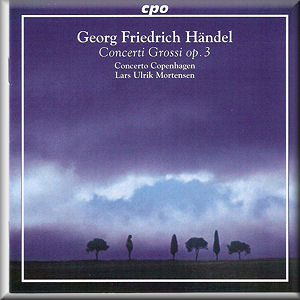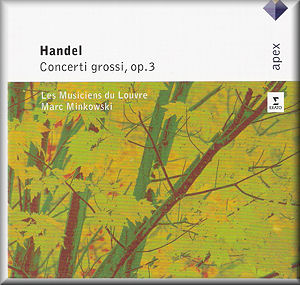 |
 |
| 

alternatively
CD: MDT
AmazonUK
AmazonUS
Sound
Samples & Downloads |
George Frideric HANDEL
(1685 - 1759)
Concerti grossi, op. 3 (1734)
 Concerto Copenhagen/Lars Ulrik Mortensen
Concerto Copenhagen/Lars Ulrik Mortensen
rec. Garnisons Kirke, Copenhagen, 4-6 June 2009. DDD
 CPO 777 488- 2 [58:35]
CPO 777 488- 2 [58:35] |


alternatively
CD: MDT |
George Frideric HANDEL
(1685 - 1759)
Concerti grossi, op. 3 (1734)
 Les
Musiciens du Louvre/Marc Minkowski Les
Musiciens du Louvre/Marc Minkowski
rec. Salle Berthier, Paris, 20-23 December 1992. DDD
 WARNER APEX 2564 68162-3 [56:15]
WARNER APEX 2564 68162-3 [56:15] |
| |
It matters little that ‘op. 3’ was compiled by the
publisher John Walsh from already existing works. It still makes
an enjoyable set.
The sturdy ritornello that opens Concerto 1 is
an impressive start even if there is always that danger that
its formality might become overbearing. The danger is avoided
with the period instrument ensemble Concerto Copenhagen. Mortensen
sets a sufficiently lively but relatively easygoing tempo. The
concertino passages in the opening movement by two oboes
and violin are lightly articulated. The performance wears its
skill lightly, aided by firm continuo presence. The outcome
is smiling and comely with a pleasing sense of chamber intimacy.
What we hear is a convivial gathering of stylish players. If
you were wishing for something a little more refined then that’s
just what comes in the slow movement. Two recorders introduce
and provide a refreshingly cool yet sheeny support to the solo
oboe who engages in a fastidious dialogue with solo violin.
This is beautifully done because, while highly embellished the
playing has an element of reticence which gives it an attractive
modesty. The other elements include smooth blend of ensemble,
clarity of texture and spaciousness of recording. The tuttis
are pleasingly full-toned without being overwhelming. After
this the third movement (tr. 3) seems rather precipitate. It’s
brief and forthright. Mortensen seems happy to wrap it up with
just a nod and grin towards its uncharacteristically more mellow
third episode for bassoon duet from 0:45. He caps this with
a return to the opening movement’s comeliness in a delightfully
florid and frisky finale. This is very satisfying because of
its light touch and its return to the opening movement’s
B flat major after two following movements in G minor. The problem
is that this is not how the concerto was published. This ‘finale’
is the fourth movement of Concerto 2 and is so recorded by Goodman,
Minkowski and Pinnock, to name three other period instrument
interpretations. I’m happy with Mortensen’s choice:
a new ‘compilation’.
It’s appropriate to compare Marc Minkowski and Les Musiciens
du Louvre as their 1992 recording has now been reissued on Warner
Apex. Minkowski’s opening movement is more dashing in
both senses, taking 2:30 against Mortensen’s 2:50. The
concertino is more ostentatious, the ripieno busier,
the whole effect more dazzling. His slow movement is balmier,
you might say more lush. Its concertino oboe and violin
undoubtedly make an elegant pair. His third movement is stimulating
and crisply done. At 1:08 faster than Mortensen’s 1:20
it sounds less hasty. He then makes it a more substantial item
to end the concerto by repeating it, apart from the opening
ritornello, so it plays for 2:17.
The opening Vivace of Concerto 2 is lightly yet
crisply articulated by Mortensen. You can really enjoy the interplay
between the concertino first and second violin. I prefer
this to the more assertive but also more tense Minkowski whose
closing cadence features an extravagant solo violin improvisation.
Mortensen Largo features as seductive period instrument
oboe playing as I’ve ever heard. It’s aided by the
support of two warm, mellow cellos. This could be Cleopatra
captivating you. The flowing tempo, more Larghetto (2:19
against Minkowski’s 3:11), certainly helps. The cantilena
becomes less self-conscious which is just what it is from Minkowski,
though his oboist too is beautifully sultry. The third movement
fugue from Mortensen is regal and sunny yet cheerily summative
where Minkowski is more formal … and sprightly. Minkowski’s
fourth movement Minuet merrily lightens the tension, though
its closing somersaults are a bit hectic. Mortensen’s
lightness of touch I find more attractive but he deploys this
dance as the fourth movement of Concerto 1. If you want it here
you have to switch back to or programme track 4. The fifth movement
Gavotte (tr. 8) from Mortensen I found a bit too steady at first.
There’s compensation in the liveliness in the bass in
its first variation (1:03) and the exuberant running quaver
triplets in the violins in the second (2:00). Minkowski has
more spirit and energy from the outset, albeit at the cost of
rather insistent accents.
Concerto 3 opens with a movement that’s no more
than a straightforward, and from Mortensen neat, sequence of
chords garnished with a recorder flourish. Minkowski has the
recorder joining in the chords too to more lavish, but for me
rather overblown, effect. The recorder also heads Mortensen’s
following cheery Allegro. It starts a bevy of semiquavers
which the concertino violin then takes up individually
and in duet. Mortensen manages to make all this both vivacious
and relaxed. Minkowski settles for activity and has a perkier
recorder, more momentum, virtuosity and edge. The brief Adagio
finds Mortensen’s recorder florid and aria-like in expression
yet reflective in manner. Minkowski’s recorder is altogether
more sensual and quite blatant about it. The fugue finale isn’t
especially inventive and outstays its welcome. Mortensen makes
it sound carefree and it’s blithely articulated. Minkowski
again goes for a more energetic approach. Its bracing outcome
is even more successful as his interpreters throw themselves
into it with such relish.
The Concerto 4 recorded here is the one usually heard.
It comes from the second printing of op. 3. To its Ouverture
Mortensen brings a trim authority and a bristling purpose which
relishes its own spikiness. The light Allegro is crisply
articulated with the doubling first and second oboe and violins
finely blended. This serves to clarify and also honour the counterpoint.
The coda has an easy majesty. Its demisemiquaver flourishing
ascents recall the introduction. Minkowski’s introduction
is more formal and polite, but only so his second section by
contrast can be more frothily skipping. It’s niftier with
more excitement and fizz. This is a more dramatized approach
with subtle light and shade in dynamic. The oboes are a touch
more prominent, the counterpoint more insistent and tense. I
like the way that in the closing section he finds more reflective
nuance by softening just before the stately closing cadence.
The slow movement again spotlights the oboe. Mortensen’s
is charming, urbane and mellifluous. Everything about the movement
is stylish: the graceful elaboration of the strings’ introduction,
the effortless oboe cantilena, the comfortable command
of phrasing, the pearly oboe embellishment of the Adagio’s
closing cadence. In comparison Minkowski rather throws away
the elaboration of the strings’ introduction and goes
for a plainer, albeit pleasingly ingenuous cantilena.
While having a pastoral lightness, he’s less willing to
relish the melodic sequences. He cedes the elaboration of the
Adagio cadence to lute continuo. This movement times
at 1:54 for Minkowski, 2:11 for Mortensen. The latter seems
to offer much more. The following Allegro from Mortensen
opens more soberly but then becomes a smoother pastoral piece.
Minkowski from the start is fast, frisky and deliciously done.
Mortensen gives a pleasing, well mannered account of the Minuet
finale with contented strut and a quiet, serene middle section.
Minkowski is much livelier: he scampers along teeming with trills.
Indeed the piece becomes an anthology of ornamentation effects,
great fun though, in the midst of which the middle section is
suitably more sedate.
The benefits of period instruments and a small ensemble are
clear in Mortensen’s Concerto 5. Its opening Andante
has a clean cut, stark line. It progresses with terse rhetoric,
proving that it’s possible to be dramatic without being
massive. Minkowski is rather more self-conscious and imposing
in his broader measure (1:41 against Mortensen’s 1:25)
though heavier when it comes to the fuller body. Mortensen’s
second movement fugue is clean of limb. The period violins’
silvery shining clarity enhances the flowering of the counterpoint.
Minkowski is crisp and light, with more dancing character than
Mortensen. Next comes a brief Adagio of sweetly distilled
sorrow from Mortensen which evokes more sympathy than Minkowski’s
beaming tone. Mortensen makes the fourth movement fugue rather
more meaty than the second’s. It is fittingly accorded
more rugged treatment with entries firmly accented. Minkowski
takes a calmer, more subdued manner in the fugue which is less
engaging than Mortensen’s. Mortensen also brings a haunting
quality to the Adagio close, like a sudden sob as a mask
is lifted. There are surprises in the Allegro finale
too, to which Mortensen brings a sotto voce treatment
as if for secretive naughtiness. The upper strings constantly
escape from the lower ones trying to echo them. There’s
a fascinatingly insubstantial central section (tr. 21, 1:05).
Mortensen conjures a diminuendo for the final phrase
which is as good a way as any to cap the music’s sheer
bravura and momentum. Minkowski tries to go one better by being
as fast and furious as possible (2:13 against Mortensen’s
2:34) but the outcome I find rather rough-hewn and tawdry.
Both recordings present Concerto 6 as Walsh compiled
it, with a rather odd finale which was actually Handel’s
first published organ concerto. Both recordings also add an
improvised organ solo middle movement. A judicious balance between
neatness and freshness characterizes the opening Vivace
from Mortensen. His emphasis is on the orderly. Minkowski goes
for a more stimulating approach with a good deal more pep. He
times at 2:25 to Mortensen’s 3:04, but Mortensen is less
exhausting for repeated hearings. In Minkowski’s account,
however, it’s good to hear the organ clearly featured
towards the end. This means that it doesn’t appear out
of the blue as the only instrument in the second movement. Mortensen
opts for an Adagio improvisation on a ground bass taking
2:21. It’s cool, meditative and makes a pleasing contrast
with the other movements. Minkowski opts for an animated display
piece of the same character as its neighbours taking 0:45. Perhaps
because of Mortensen’s intervening contrast his finale
has more compelling zip with both organ and orchestra in vibrant
form. Minkowski is lively too but his phrase-ends, in comparison,
seem just a touched clipped and less punchy than those from
Mortensen.
To sum up, then, Minkowski offers displays of virtuosity and
excitement at an attractive reissue price. Warner Apex don’t
supply booklet notes but with such well-known works I don’t
mind. Minkowski is undeniably stimulating. Mortensen, however,
gives us state of the art interpretations for today. I left
his CD less energized than with Minkowski but more satisfied.
There’s more sense of the engaging comeliness of the music’s
variety and elegance.
Michael Greenhalgh
|
|

